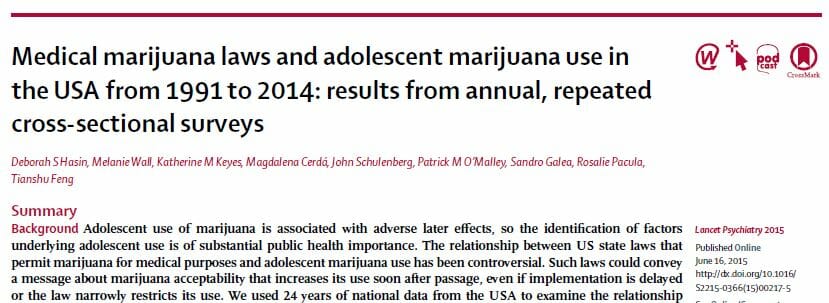Premium Hemp Products

Adolescent use of marijuana, according to groups that are against any use of the plant, like the Partnership for Drug-Free Kids (who should be barking at BigPharma; buy hey, what do we know?!), is associated with adverse effects later in life. For them, the identification of factors underlying adolescent use is of significant public health importance.
The relationship between US state laws that permit cannabis for medical purposes and adolescent marijuana use has been a hot topic of debate. The claim is that these laws convey a message about cannabis acceptability that increases its use in adolescents soon after passage. A recent study utilized 24 years worth of national data from the USA to examine the relationship between state medical cannabis laws and adolescent use of marijuana.
The study’s authors use a multistage, random-sampling design with replacement, compiled from surveys conducted annually amongst national surveys of 8th, 10th, and 12th-grade students (modal ages 13–14, 15–16, and 17–18 years, respectively), in about 400 schools each year. Students in these schools complete anonymized, self-administered questionnaires that include questions on cannabis use. They analysed data from 1,098,270 adolescents surveyed between 1991 and 2014. The primary outcome of this analysis was any marijuana use in the previous 30 days. They utilized a multilevel regression modelling with adolescents nested within states to examine two questions. “The first was whether marijuana use was higher overall in states that ever passed a medical marijuana law up to 2014,” according to the study. “The second was whether the risk of marijuana use changed after passage of medical marijuana laws. Control covariates included individual, school, and state-level characteristics.”
What did the study’s authors’ find?
Marijuana use was more prevalent in states that passed a medical marijuana law any time up to 2014 than in other states (adjusted prevalence 15·87% vs 13·27%; adjusted odds ratio [OR] 1·27, 95% CI 1·07–1·51; p=0·0057). However, the risk of marijuana use in states before passing medical marijuana laws did not diff er significantly from the risk after medical marijuana laws were passed (adjusted prevalence 16·25% vs 15·45%; adjusted OR 0·92, 95% CI 0·82–1·04; p=0·185). Results were generally robust across sensitivity analyses, including redefining marijuana
use as any use in the previous year or frequency of use, and re-analyzing medical marijuana laws for delayed effects or for variation in provisions for dispensaries.Our findings, consistent with previous evidence, suggest that passage of state medical marijuana laws does not increase adolescent use of marijuana. However, overall, adolescent use is higher in states that ever passed such a law than in other states. State-level risk factors other than medical marijuana laws could contribute to both marijuana use and the passage of medical marijuana laws, and such factors warrant investigation.